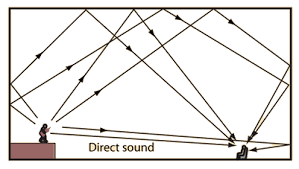Disclosure: As an Amazon Associate I earn from qualifying purchases.
Noise and noise at home or in the office can be dampened by a sound absorber even without expensive renovation work .
In the following article, you can find out how to simply dampen sound in your rooms and even beautify your walls.
Unpleasant room acoustics due to sound that is not attenuated
When you enter an empty apartment or a large, empty room, the first thing you notice is the echoing room acoustics. In an empty room, noises are often much louder and more unpleasant to the ears than in a fully furnished room.
The term gym effect describes this condition quite well. Because everyone knows the uncomfortable room acoustics of a gym.
Room acoustics of this kind arise from the fact that the sound in empty rooms is reflected unhindered by the floor and walls and is not attenuated.
But even in furnished rooms one is not completely immune to such an effect. This is due to hard surfaces such as parquet, glass, concrete, smooth plastic surfaces and even treated wood. Such surfaces do not pick up the sound, but reflect it and thus throw it back into the room. Reverberation arises.
The reverberation is the problem
So it is the reflection of sound that creates the unpleasant reverberation. The term reverberation is the continuous reflection of sound waves (sound reflections) in an enclosed space.
Smooth surfaces reflect sound back into the room in a similar way as a mirror reflects light. The reverberation is then created through these repetitive sound reflections. And that reverberation is a problem.

The following schematic drawing shows how reverberation (blue) comes about. For a better understanding, I have also drawn the occurrence of direct sound (red) and early reflections (green).
Here you can see that the reverberation (blue) is reflected several times from different surfaces and is the last to reach the listening location.
In contrast to this, early reflections (green) in this example reach the listening location after only one reflection directly after the direct sound.
The most direct sound is direct sound (red), which arrives first at the listening point without sound reflections.
Basically one can say that a long reverberation time leads to a high sound level and an unpleasant background noise. Often a long reverberation time is also noticeable when language is no longer understood as well. The result is an uncomfortable mish-mash of words that are no longer easy to understand. This makes it difficult to follow individual conversations in a concentrated manner. Listening is made difficult.
But also a disturbing background noise can be a consequence of a long reverberation time in the room. The following applies: the longer the reverberation time, the more uncomfortable. And vice versa: the shorter the reverberation time, the better.
Soft objects and materials can help. Of course, furniture also helps against this effect, which – depending on the surface – can not only dampen the sound, but also scatter it. That is why a furnished room sounds much more pleasant than an empty room.
But heavy curtains, carpets and special wallpapers are also able to dampen the sound.
However, the best means of reducing reverberation and soundproofing are so-called sound absorbers.
What are sound absorbers?
Sound absorbers are usually made of acoustic foams and have an open-pored surface with a low density. This allows sound absorbers to pick up sound waves instead of reflecting them. Sound absorbers are therefore able to effectively dampen noise and sound.
Different foams can be used, for example convoluted foam, pyramid foam or composite foam.
The only important thing is: sound absorbers can effectively reduce reverberation in the home.
And that actually works very well in practice. Anyone who has ever been to a recording studio, and especially in a singing booth, will know the prevailing acoustics there. Sound absorbers made of acoustic foams ensure that the reverberation is sustainably reduced.
The more sound absorbers the better?
The crowd does it. The following rule applies to sound absorbers: the more acoustic foam is used, the more reverberation is absorbed. This game could now be taken to extremes and the entire room (walls and ceiling) covered with acoustic foam.
If almost no sound is reflected in a room, then one speaks of an anechoic room, which is sometimes called an anechoic room. Such conditions are ideal especially for certain sound recordings, such as the recording of a radio play.
In your own four walls, in the living room or in the office, you usually don’t want to have an anechoic room. This would also hardly be feasible structurally in practice. The floor and existing windows alone would prevent this.
Broadband absorber
Sound absorbers and acoustic foams are available in different designs. In general, it can be said that thicker materials can also absorb low frequencies, while thin materials mainly absorb the highs.
Sound absorbers, whose absorption effect covers a very broad frequency spectrum, are called broadband absorbers. Such absorbers can absorb highs, mids and even a little bass. Such broadband absorbers are made of thicker material.
Thanks to the wide range of different absorbers, everyone can create their own individual room sound.
Sound absorbers for the home
Sound absorbers are by no means only used in recording studios, but also in apartments, offices, practices, law firms, meeting rooms, conference rooms, schools, and in many other rooms in which the room acoustics are to be improved.
However, since we are concerned with the issue of quieter living, we are particularly looking at sound absorbers for the home.
Because such sound absorbers can also work wonders at home when it comes to soundproofing in your own four walls.
Where are sound absorbers installed?
Sound absorbers are available in different shapes and colors and can be attached to various positions in the apartment or set up freely. You can find some typical uses in the following list:
- Freely set up as a room divider or partition
- Set up freely as an acoustic column or pyramid
- On the ceiling or a suspended ceiling
- Hanging freely from the ceiling as a ceiling sail
- On the wall, e.g. as an acoustic picture or as an individual element
- On the wall as a sound absorber, e.g. in the children’s room
- At the desk as a table partition in offices
- On the floor, e.g. for impact sound insulation or structure-borne sound insulation
Sound absorbers for the wall as acoustic pictures
If you want to absorb the sound in your home, you usually not only value the right sound absorber, but of course also a suitable design.
While the color and design of sound absorbers in a recording studio are often only secondary, these issues are the focus when used in your own four walls. After all, it should be as cozy and stylish as possible at home. Nevertheless, the functionality should not be neglected.
Sound absorbers are not small and must have a certain footprint to be effective. You cannot discreetly hide these aids. That is why they made a virtue out of necessity and developed special sound absorbers that not only work well, but also look good.
These are mostly sound absorbers for the wall.
Such sound absorbers, such as these here, which can be purchased from Amazon * , basically look like a picture and are often structured as follows. The actual material for sound insulation is located inside the sound absorber. This can be a fleece membrane or mineral wool fiber.
The whole thing is then covered with an acoustic fabric, which can come in different colors. The structure is held together by an inner frame, which is usually made of wood or aluminum.
In order to attach the sound absorber to the wall, the appropriate accessories are often included. Attention should be paid to this.
The sound absorber can easily be attached to the wall like a picture.
There are even so-called acoustic pictures. In principle, these are sound absorbers that are designed like a picture. Sound absorbers can therefore also be design elements that are beautiful to look at.
If you like it individual and practical at the same time, if you want to combine style with utility, you should look out for acoustic pictures for your home .
Such acoustic pictures are also available in several parts ( such as this one here on Amazon * ) so that they can cover a larger area on the wall.
Sound absorber for sound insulation to the outside
In addition to sound absorbers for reducing reverberation in a room, there are also special sound absorbers for sound insulation inwards or outwards. Such sound absorbers are usually quite heavy and are intended to prevent sound waves from penetrating walls.
More tips to dampen the noise in the apartment and improve the room acoustics
- Large rooms with few objects appear louder
- Soft and absorbent materials make the room appear quieter
- A thick and fluffy carpet has a positive effect on the room acoustics and reduces footfall noise
- Tile floors are inconvenient because they reflect sound
- Glass, mirrors, steel and hard, smooth surfaces also reflect sound
- Upholstered furniture can absorb sound to a certain extent
- Heavy and thick curtains and tapestries can reduce noise
Conclusion
The room acoustics also determine whether we feel comfortable. With suitable sound absorbers for walls in the apartment, rooms can be soundproofed more easily.
Disclosure: Amazon and the Amazon logo are trademarks of Amazon.com, Inc, or its affiliates.




